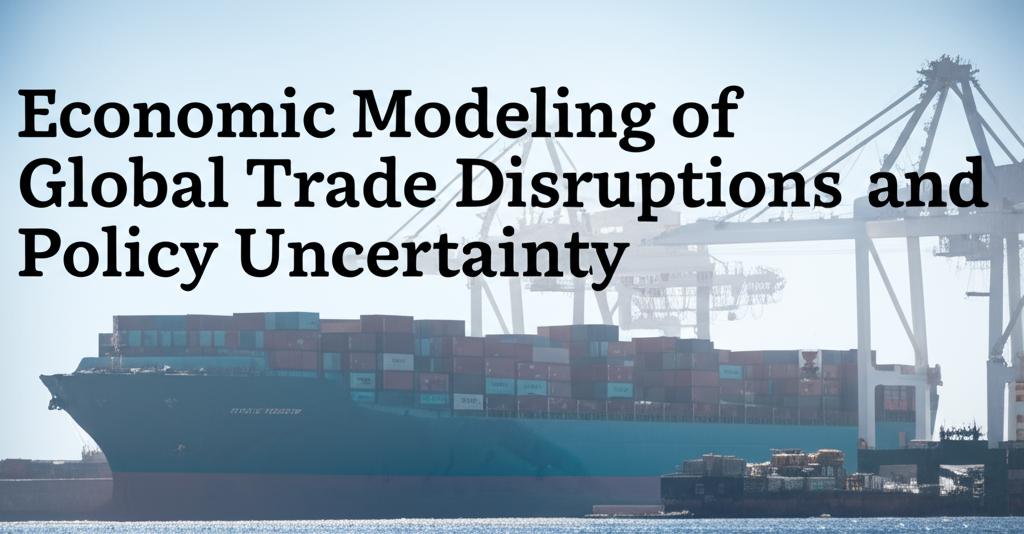The global economic landscape is increasingly characterized by significant trade disruptions and pervasive policy uncertainty. Events ranging from pandemics and geopolitical conflicts to sudden shifts in trade policy have created a complex and volatile environment for international commerce. Understanding the potential impacts of these factors is crucial for businesses and policymakers alike, and economic modeling plays a vital role in this effort.
Economic models are being adapted and developed to better capture the effects of various disruptions on global trade flows, supply chains, and overall economic activity. Supply chain bottlenecks, stemming from factors like logistical challenges (including container misplacement and congestion), semiconductor shortages, labor shortages, and pandemic-related restrictions, have been a major focus. Models like Vector Autoregressions (VARs) are used to quantify the impact of these supply shocks on key variables such as industrial production, exports, imports, and inflation, often utilizing timely data like Purchasing Managers' Indexes (PMIs). Studies indicate these disruptions generally reduce global production and trade while pushing up prices. Some models explicitly incorporate inventory management decisions by firms, showing how disruptions like increased shipping times lead to output contractions, price hikes, and stockouts, particularly when inventory levels are already low.
Geopolitical risks represent another significant source of disruption rigorously analyzed through economic modeling. Trade wars, protectionist measures like tariffs and quotas, sanctions, political instability, and armed conflicts directly impact trade flows, transportation routes, and market access. Recent events, such as the war in Ukraine, tensions in the Middle East affecting shipping routes like the Red Sea, and US-China trade friction, have demonstrated the cascading effects on global commodity markets (especially energy and food), shipping costs, and overall economic stability. Models like Computable General Equilibrium (CGE) frameworks, which capture detailed interactions between different sectors and countries, are employed to assess these economy-wide impacts. Increasingly, models incorporate measures of geopolitical alignment, finding that trade volumes tend to grow more slowly between geopolitically distant countries. The concept of "geoeconomic fragmentation," where trade and investment flows increasingly follow geopolitical lines, is a growing area of research.
Policy uncertainty, particularly regarding trade policy (TPU) and broader economic policy (EPU), is a distinct but related challenge. Economists construct measures of uncertainty using various sources, including newspaper coverage, analysis of company earnings calls, and volatility in tariff rates. These uncertainty measures are then incorporated into macroeconomic models (like VARs and Dynamic Stochastic General Equilibrium - DSGE models) and trade-specific models (like gravity models) to estimate their effects. A consistent finding across numerous studies is that heightened policy uncertainty acts as a drag on the economy. It tends to reduce business investment, as firms delay decisions due to the unclear future policy environment (the "real options" effect). This hesitation can lead to lower overall economic activity, reduced hiring, and dampened trade flows. Some models show uncertainty can induce firms to increase markups as a precautionary measure, contributing to inflation. While both tariff hikes and uncertainty have negative effects, some recent research suggests that the direct impact of tariff changes might be more significant than the uncertainty surrounding them in certain periods.
The interaction between disruptions and uncertainty is critical. Uncertainty can exacerbate the negative impacts of supply chain disruptions, while major disruptions often fuel further policy uncertainty. Modeling efforts are increasingly focused on capturing these interactions and the resulting shift towards building resilience in supply chains, sometimes even leading companies to streamline by working with fewer, potentially more reliable, suppliers rather than broad diversification. Advanced modeling techniques, including machine learning for forecasting and detailed network analysis of global value chains (GVCs), are being explored to provide more granular insights and predictive power. Participation in complex GVCs, while offering efficiency benefits, can also amplify the negative effects of uncertainty and disruptions across borders.
In conclusion, economic modeling provides indispensable tools for navigating the complexities of modern global trade. By quantifying the potential consequences of supply chain issues, geopolitical events, and policy uncertainty, these models help inform strategic decisions aimed at mitigating risks and enhancing economic resilience in an unpredictable world. The continuous refinement of these models is essential as the global economy continues to face novel challenges and structural shifts.

